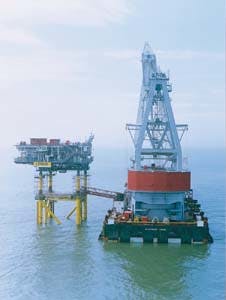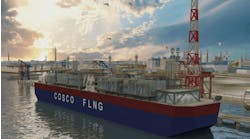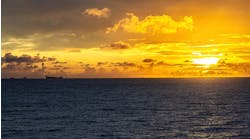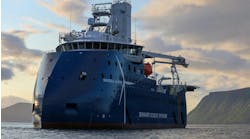Europe's underwater engineering contractors are increasingly prepared to adapt their vessels to secure pipelay work. Star name recent examples include the Stena Apache, refitted for deepwater rigid steel line laying for Petrobras, and the Norlift, modified for steel line laying on BP's Foinaven installation.
A less publicised conversion was performed last year on Italian contractor Rana's derrick barge ODS Mariner. To handle pipelaying on Egypt's Geisum Field, Rana decided to convert the vessel to a laybarge: it was already equipped with a 200 ton crane with one main hoist and a jib with lift capacity of 30 tons.
JP Kenny Caledonia performed the feasibility study and subsequent design, with Arab Contractors, Egypt prefabricating the 80 ton-plus steelwork for the conversion, supervised by Rana. The contractor itself installed the hardware over a two-week period.
The refitted barge now has a firing line installed on its port side equipped with four welding stations, one x-ray station and a field joint coating station, along with pipe racks and ancillaries. Laying equipment includes a Remacut type, 40 ton tensioner and a 40 ton A&R winch.
ODS Mariner can now lay pipes of varying diameter, according to design criteria such as water depth, coating thickness and weight. For Geisum (water depth 30-40 metres) the barge installed two 8-in. lines (one water injection and one crude oil); two 12-in. lines (one crude and one oil line to shore); and associated tie-ins: total length 8-km.
Rana's workscope included engineering, fabrication and procurement of these lines as well as building and installing a riser frame at Geisum's WPC platform. It also excavated a coral reef trench (over 2,000 cu metres) to allow laying of four 400-metre spools.
Two power cables were installed connecting WPC to the field's WPA and WPD platforms. Rana also performed free-span rectification and line stabilisation, through installation of mattresses and grout bags; pigging and hydrotesting of all lines; and an as-built survey of all lines and cables laid using an ROV.
Work was completed this year. Currently the contractor is bidding the barge for another 8-in. line on Geisum, this time 10 km long, to connect WPA with a new platform called Tawila. Rana is also tendering for a new field development in the Northern Adriatic, and for an oil line associated with the construction of two power plants in Lebanon.
Heavy lift vessel Stanislav Yudin on site at Liverpool Bay recently, installing the Lennox unmanned satellite platform. Lennox, with a jacket and topsides weight of 1560 tones, will be used to separate oil and gas from the BHP field development.
Norlift
In the UK, McDermott Marine Construction's Norlift is now one of just two North Sea vessel capable of laying reeled steel pipe. Prior to its just finished conversion at the Tees Offshore Base in England, the vessel was used mainly for installation of flexible flowlines and umbilicals. The steel line laying capability clinched for the vessel the BP Foinaven installation west of the Shetlands.
Conversion involved removing its original Dynlay system, strengthening the underdeck and fitting a vertical, 18-metre diameter pipespool capable of handling 1,250 tons of reeled pipe. Sonardyne has supplied an integrated long-ultra short baseline positioning system to act as the seabed reference for the vessel's DP system and to provide high accuracy positioning for ROV tracking and pipelaying operations.
Norlift can now lay pipes up to 12-in. diameter in waters over 1,000 metres deep. For Foinaven, McDermott also purpose buiilt a pipe fabrication and spoolbase at Ardersier, Scotland, for direct loading of reels onto the vessel.
Following the Foinaven installation, which is likely to continue well into this autumn, the vessel is booked next year for four to six weeks from May installing the subsea flowlines on Shell/Esso's Teal, Teal South, and Guillemot development. The twin flowlines will carry commingled hydrocarbons from the production manifold, 30-40 metres from the subsea wellhead cluster, to flexible risers and processing facilities on the FPSO.
Norlift's sister vessel Northern Explorer is also working on the same field developments, performing trenching duties. Both vessels, operated by Northern Ocean Services since the mid-1980s, have been part of the McDermott empire since the takeover last year.
At one point their future looked complicated when a marine services merger with Stolt Comex Seaway was a possibility. Until that fell through, there was potential for overcrowding, in light of McDermott's separate pipelaying venture with ETPM.
Now, however, the picture is becoming clearer. As part of the McDermott Subsea operation in Aberdeen, NOS will bid subsea EPIC work with sister design company Mentor; alternatively, it can provide small diameter pipelay back-up to the large diameter lay vessels of McDermott-ETPM, or duplicate its role on Foinaven on other fields where McDermott Marine Construction is providing integrated services management.
According to NOS's managing director Stuart Oakley, most of the company's operations will transfer to Aberdeen this autumn, but not those on Tees Offshore Base, where NOS will continue to use the Offshore Technology Centre for subsea production equipment tests. The move was held back so as not to disrupt current project work.
Both Norlift and Northern Explorer will be bid for work mainly in Northwest Europe and Australia. They are outside contenders for work in Brazil should something cause Coflexip-Stena Offshore's stranglehold there to slip.
It may help that NOS has become one of the latest companies to receive safety management certificates to Lloyd's Register's ISM Code assessment for its two offshore support vessels, as well as ISO 9002 certification from LRQA. NOS is ahead of the game here: mandatory implemntation of the code as part of SOLAS comes into effect from 2002 for many types of large vessels and mobile drilling units.
Copyright 1995 Offshore. All Rights Reserved.




